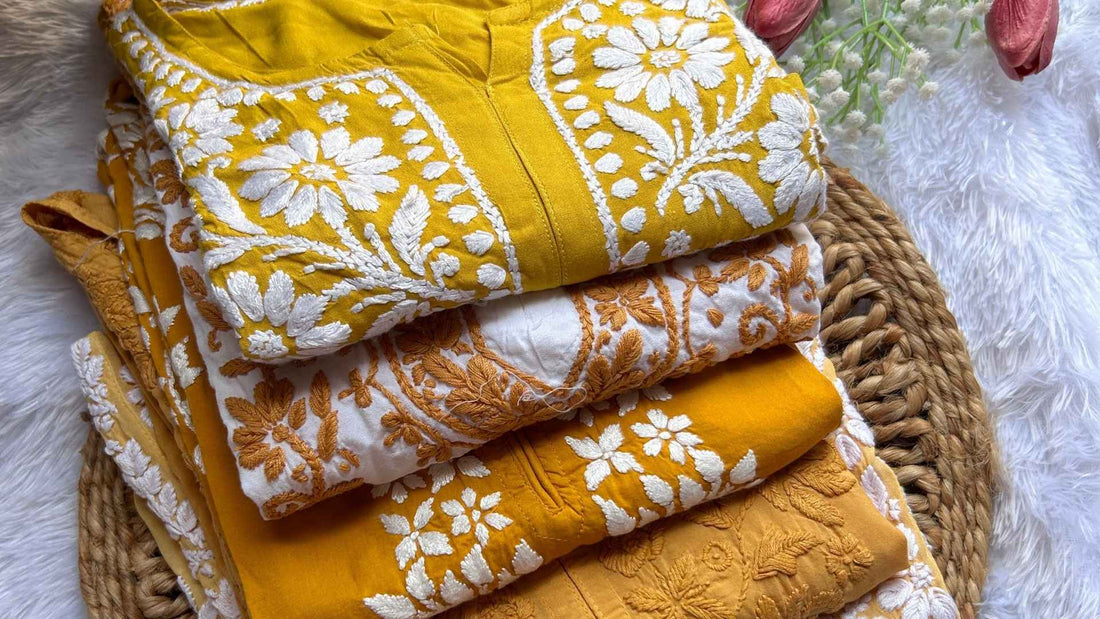
The Evolution of Chikankari: Lucknow's Timeless Embroidery Art
Share
Chikankari – the delicate hand embroidery of Lucknow – is more than just a craft. It is a living heritage, passed down through centuries, reflecting the elegance of Indian artistry. From royal courts to modern wardrobes, Chikankari has traveled a fascinating journey, evolving while preserving its timeless charm.
The Royal Beginnings of Chikankari
Chikankari traces its roots back over 400 years to the Mughal era. It is believed that Empress Nur Jahan, known for her refined taste in textiles, introduced this art to Lucknow. The craft flourished under the patronage of the Mughal courts, where artisans created intricate patterns on muslin – a fabric so fine it was called woven air.
Chikankari in Nawabi Lucknow
When the Nawabs of Awadh made Lucknow their capital, Chikankari embroidery found a new cultural home. The Nawabs loved elegance and subtle beauty, and Chikankari became an essential part of court fashion. During this period, designs expanded, stitches became more refined, and the art grew into the identity of Lucknow itself.
The Colonial Influence and Decline
With the arrival of the British, Chikankari artisans faced hardship. Machine-made fabrics and changing tastes led to a decline in demand. Many artisans struggled to sustain themselves, and the art was at risk of being forgotten. Yet, its beauty could not be overshadowed, and it quietly lived on in the bylanes of Lucknow.
Chikankari in Modern India
Post-independence, Chikankari made a comeback as designers and patrons recognized its cultural value. Today, it is not just a heritage craft but also a global fashion statement. Modern Chikankari is done not only on traditional cotton and muslin, but also on georgette, chiffon, silk, and organza. From kurtis and sarees to fusion wear, it blends tradition with contemporary fashion.
The Timeless Stitches of Chikankari
Chikankari is unique for its variety of stitches – more than 30 types! From the shadowy Bakhiya to the raised Phanda and the delicate Jaali, each stitch adds depth and artistry. These techniques have remained unchanged for centuries, proving the timelessness of hand embroidery.
Chikankari Today – A Global Trend
Fashion designers in India and abroad have embraced Chikankari for its elegance. Bollywood celebrities and international icons often showcase Chikankari outfits on red carpets and in everyday fashion. With rising global demand, artisans are once again gaining recognition for their painstaking craft.
Why Chikankari is More than Fashion
Chikankari is not just clothing – it is heritage you can wear. Every motif, every stitch carries the story of artisans who keep this tradition alive. Owning a Chikankari outfit means becoming part of a craft that has survived centuries of change, yet remains timeless.
Final Word
The journey of Chikankari – from the Mughal courts to global fashion ramps – is a testament to its timeless elegance. At Hayat’s Lucknowi, we take pride in carrying forward this legacy, offering handcrafted Chikankari pieces that blend tradition with modern style.
Discover our Chikankari collection and own a piece of Lucknow’s heritage today.
